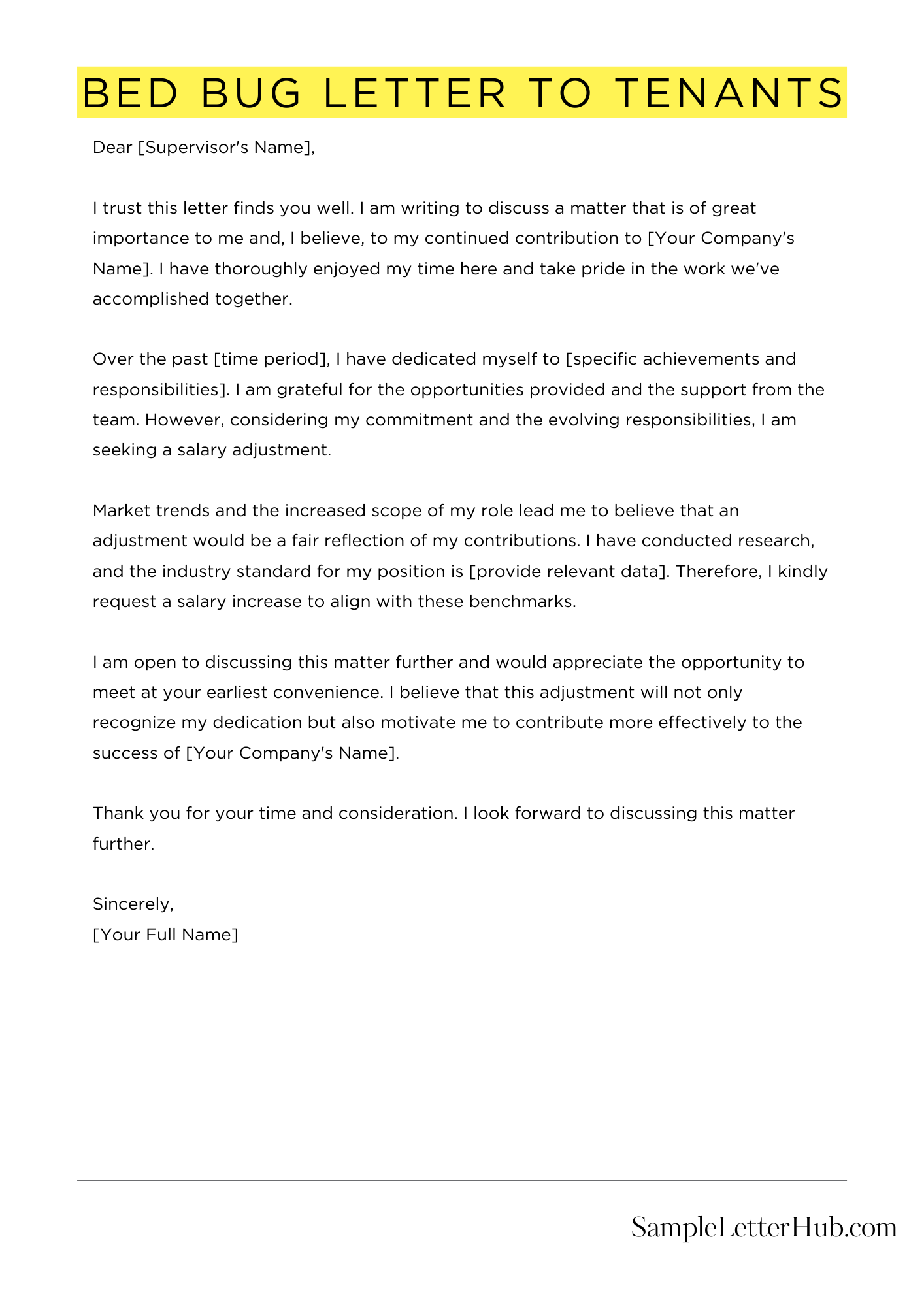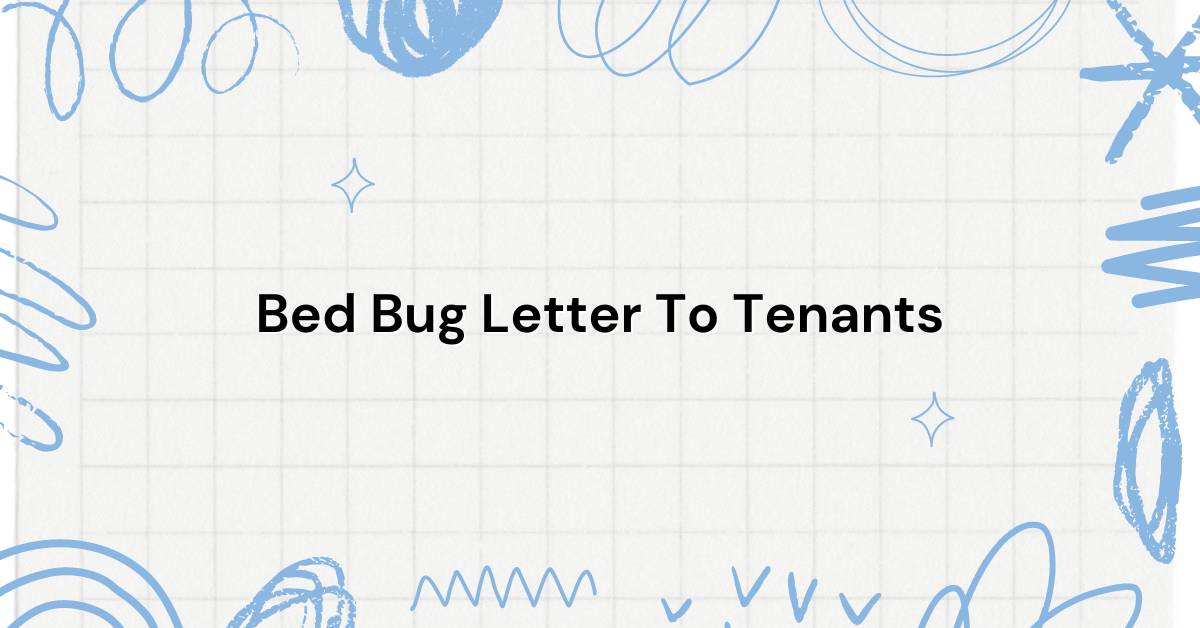Bed Bug Letter To Tenants is a formal notice that a landlord sends to tenants informing them about the presence of bed bugs in the rental unit. The purpose of this letter is to provide tenants with important information about the infestation, including the steps they need to take to address the issue.
In this article, we will share templates, examples, and samples of Bed Bug Letter To Tenants. These letters are designed to make it easy for landlords to communicate with their tenants about bed bug infestations. The letters cover a range of scenarios, including initial notifications, follow-up notices, and requests for cooperation.
Bed Bug Letter to Tenants
Dear Valued Tenants,
We are writing to inform you of a recent report of bed bugs in our building. We understand that this news may be concerning, and we want to assure you that we are taking all necessary steps to address the situation.
Bed bugs are small, wingless insects that feed on human blood. They are often found in mattresses, box springs, and other furniture. While they are not known to transmit diseases, their bites can cause itching, irritation, and allergic reactions.
We have contacted a licensed pest control company to inspect the affected unit and treat the infestation. The treatment will involve the use of insecticides and other methods to eliminate the bed bugs.
To assist in the treatment process, we kindly request your cooperation in the following ways:
* Vacuum your unit thoroughly, paying special attention to carpets, rugs, and furniture.
* Wash all bedding, curtains, and other fabrics in hot water and dry them on high heat.
* Inspect your furniture for any signs of bed bugs, such as small, brown spots or eggs.
We understand that this may be an inconvenience, but your cooperation is essential to ensure the effectiveness of the treatment.
The pest control company will be conducting the treatment on [Date]. Please make arrangements to be out of your unit during the treatment.
We will keep you updated on the progress of the treatment and provide any further instructions as necessary.
In the meantime, if you have any questions or concerns, please do not hesitate to contact us.
Thank you for your understanding and cooperation.
Sincerely,
[Your Name]

How to Write Bed Lease Contracts for Tenants
**1. Introduction**
A bed lease contract is a legal agreement between a landlord and a tenant that outlines the terms of the tenancy, including the rent amount, the lease term, and the tenant’s obligations. It is important to have a well-written bed lease contract in place to protect both the landlord and the tenant.
**2. Key Clauses**
The following are some of the key clauses that should be included in a bed lease contract:
* **Rent amount and due date:** This clause should specify the amount of rent that is due each month and the date on which it is due.
* **Security deposit:** This clause should specify the amount of the security deposit that the tenant is required to pay. The security deposit is typically used to cover any damages to the property that are caused by the tenant.
* **Term of the lease:** This clause should specify the length of the lease term. The lease term can be for any length of time, but it is typically for one year.
* **Tenant’s obligations:** This clause should outline the tenant’s obligations, such as paying rent on time, keeping the property clean and in good repair, and not disturbing other occupants of the building.
* **Landlord’s obligations:** This clause should outline the landlord’s obligations, such as providing a habitable living space, making repairs to the property, and following all applicable laws.
**3. Legal Language**
It is important to use clear and concise legal language in a bed lease contract. This will help to ensure that both the landlord and the tenant understand the terms of the agreement. It is also a good idea to have a lawyer review the contract before it is signed.
**4. Signatures**
The bed lease contract should be signed by both the landlord and the tenant. Once the contract is signed, it is binding on both parties.
**5. Additional Considerations**
In addition to the key clauses listed above, there are a number of other considerations that should be taken into account when writing a bed lease contract. These include:
* **Subletting:** If the tenant plans to sublet the property, this should be stated in the contract.
* **Pets:** If the tenant plans to have pets, this should be stated in the contract.
* **Insurance:** The tenant should be required to obtain renter’s insurance.
* **Eviction:** The contract should include a clause that outlines the grounds for eviction.
**6. Conclusion**
A well-written bed lease contract is essential for protecting both the landlord and the tenant. By taking the time to carefully draft the contract, you can help to avoid misunderstandings and legal problems in the future.
**7. Resources**
The following resources can provide you with more information on writing bed lease contracts:
* [Nolo’s Guide to Landlord-Tenant Law](https://www.amazon.com/Nolos-Guide-Landlord-Tenant-Law/dp/1413324827)
* [The Legal Aid Society of New York City’s Landlord-Tenant Law Guide](https://www.legalaidnyc.org/get-legal-help/article/landlord-tenant-law-guide)
* [The National Apartment Association’s Model Lease Agreement](https://www.naahq.org/advocacy/model-lease-agreements)
FAQs about Bed Bug Letter To Tenants
What should be included in a bed bug letter to tenants?
A bed bug letter to tenants should include the following information:
- A clear statement that bed bugs have been found on the property
- The location of the infestation
- The steps that tenants need to take to prepare for treatment
- The date and time of the treatment
- The contact information for the landlord or pest control company
What are the legal requirements for landlords when it comes to bed bugs?
The legal requirements for landlords when it comes to bed bugs vary from state to state. However, in general, landlords are required to:
- Disclose any known bed bug infestations to tenants
- Take steps to prevent bed bugs from entering the property
- Treat bed bug infestations promptly and effectively
What are the most common signs of a bed bug infestation?
The most common signs of a bed bug infestation include:
- Small, brown or black bugs on the mattress, sheets, or furniture
- Bloodstains on the sheets or mattress
- Itchy, red bumps on the skin
- A musty or sweet odor
How can tenants prevent bed bugs from entering their home?
Tenants can prevent bed bugs from entering their home by taking the following steps:
- Inspect used furniture and bedding before bringing it into the home
- Vacuum and clean regularly
- Seal any cracks or holes in the walls or floors
- Use bed bug covers on mattresses and box springs
What should tenants do if they find bed bugs in their home?
If tenants find bed bugs in their home, they should take the following steps:
- Contact the landlord immediately
- Vacuum and clean the infested area thoroughly
- Wash all bedding and clothing in hot water
- Dispose of any infested furniture or belongings

